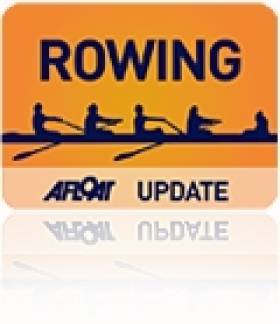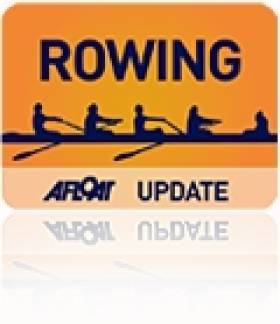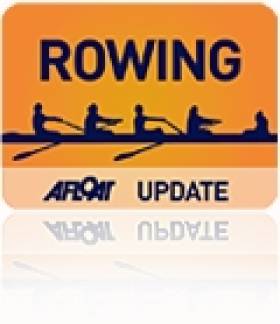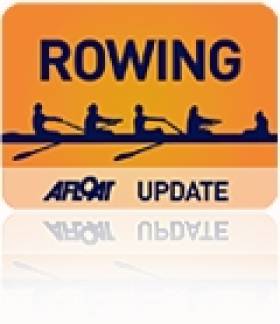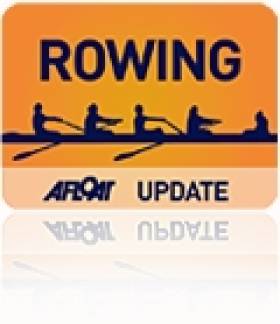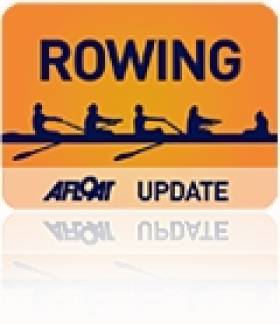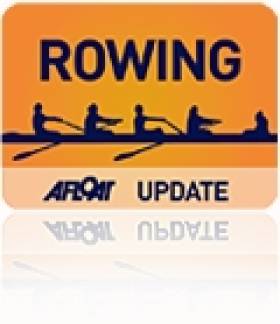Displaying items by tag: O'Donovan,
# ROWING: Ireland’s two junior single scullers showed plenty of heart but could not quite make the A/B semi-finals at the World Rowing Championships in Plovdiv this morning.
Paul O’Donovan missed out by less than a tenth of a second in his quarter-final. The Skibbereen man lay in fifth and well off qualification at halfway. However, he mounted his customary mighty push in the second half of the race and caught up with third-placed Pilip Pavukou of Belarus. The Belarussian fought back and retained third place by .9 of a second at the finish. Azerbaijan and Germany filled the first two places. O’Donovan, who had been fourth in this discipline last year, is now set for the C/D Semi-Finals.
Kate O’Brien, making her debut at these Championships, fought bravely in her race and was in a good fourth place with 500 metres to go. But the race got away from the 17-year-old St Michael’s woman in the final quarter and she finished fifth. Romania, Sweden and Poland took the three qualification places and Russia was fourth.
World Rowing Championships, Plovdiv, Bulgaria – Day Three (Irish interest)
Men
Junior Pair – Repechage Four (First Two to A/B Semi-Final; rest to C/D Semi-Final): 1 Ireland (C Black, J Cassells) 6:53.11, 2 Czech Republic 6:53.55; 3 Spain 6:56.80, 4 Ukraine 7:19.31, 5 Denmark 7:28.63.
Junior Single Sculls – Quarter-Final Two (First Three to A/B Semi-Final; rest to C/D Semi-Final): 1 Azerbaijan 7:08.77, 2 Germany 7:11.13, 3 Belarus 7:12.37; 4 Ireland (P O’Donovan) 7:12.46, 5 Austria 7:27.00, 6 Denmark 7:34.99.
Women
Junior Single Sculls – Quarter Finals (First Three to A/B Semi-Final; rest to C/D Semi-Final): 1 Romania 8:02.92, 2 Sweden 8:07.68, 3 Poland 8:09.84; 4 Russia 8:13.92, 5 Ireland (K O’Brien) 8:17.69, 6 Tunisia 8:29.53.
# ROWING: Paul O’Donovan took second in his heat of the junior single sculls to ease into the quarter-finals of the World Rowing Championships in Plovdiv in Bulgaria. China’s Ganggang Li ran away with the race. Four of the five crews qualified, but the big Chinese sprinted away from the rest and was never caught. O’Donovan came closest, but even the pugnacious Skibbereen man could not wrest the lead from Li Ganggang. Zimbabwe and Estonia took third and fourth, while Japan, in fifth, lost out.
Kate O’Brien will also compete in the quarter-finals of the junior women’s single scull. A good scull in her heat by the St Michael’s athlete saw her take third place behind Belarus and Chile and ahead of Ukraine, with all four qualifying.
World Senior and Junior Rowing Championships, Plovdiv, Bulgaria – Day Two (Irish interest)
Men
Junior Pair – Heat Three (Winner directly to A/B Semi-Final; rest to repechages): 1 Romania 6:46.98, 2 Germany 6:53.83, 3 Poland 6:58.00, 4 Ireland (C Black, J Cassells) 6:59.13, 5 Estonia 7:13.74.
Junior Single Scull – Heat Four: 1 China (G Li) 7:08,24, 2 Ireland (P O’Donovan) 7:13.05, 3 Zimbabwe (P Purcell Gilpin) 7:14.77, 4 Estonia (A Luenekund) 7:22.12; 5 Japan 7:27.06.
Women
Junior Single Scull – Heat Four (Four Guaranteed Quarter-Finals; fastest of rest to Quarter-Finals; rest to Final E): 1 Belarus (K Staraselets) 7:57.89, 2 Chile (N Sanchez Rojas) 8:09.53, 3 Ireland (K O’Brien) 8:13.90, 4 Ukraine (D Serebrianska) 8:16.83; 5 Uganda 10:14.48.
#ROWING: Niall Kenny and Mark O’Donovan finished third in their heat of the lightweight double scull to qualify directly for the semi-finals at the Olympic Qualification Regatta in Lucerne in Switzerland today. Australia were the clear winners and Poland were second.
Olympic Qualification Regatta, Lucerne (Irish interest)
Men
Lightweight Double Scull (First Three From Heats Straight to A/B Semi-Finals; rest to Repechage) – Heat One: 1 Hungary (Z Hirling, T Varga) 6:32.80, 2 Bulgaria 6:37.98, Austria 6:39.59. Heat Two: 1 Australia (R Chisholm, T Gibson) 6:26.56, Poland 6:34.06, 3 Ireland (M O’Donovan, N Kenny) 6:36.01, 4 Turkey 6:40.65, 5 Armenia 7:10.88. Heat Three: United States (A Campbell Jr, W Daly) 6:24.40, 2 Spain 6:24.71, 3 Switzerland 6:35.65; 4 Czech Republic 6:49.21.
Women
Single Scull (First Two in Heats Straight to A/B Semi-Finals) – Heat One: 1 Serbia (I Obradovic) 7:27.70, 2 Estonia (K Pajusalu) 7:34.28. Heat Two: 1 Australia (K Crowe) 7:29.48, 2 United States (G Stone) 7:32.00. Heat Three: 1 Denmark (F Erichsen) 7:32.66, 2 Ireland (S Puspure) 7:35.85; 3 Norway (T Gjoertz) 7:35.88, 4 Latvia (E Gulbe) 7:53.35, 5 Bulgaria (LM Rusinova) 7:58.28
#ROWING: Two Irish single scullers reached A Finals on the first day of the the huge Munich Junior Regatta. Bridget Jacques finished fifth in a race won by world junior champion Anne Beenken of Germany. Beenken pipped Jacques’s fellow Northern Irish woman Holly Nixon for gold last year at the World Championships.
Paul O’Donovan, who finished fourth at those Championships, had a rare off-day in his final today and finished sixth.
Munich Junior International Regatta (Day One, Selected Results)
Men
Four – Heat One: 4 Ireland (L Seaman, H Millar, C Black, J Cassells) 6:20.86. B Final: 3 Ireland 6:24.24.
Single Scull - Heat Four: 1 Ireland (P O’Donovan) 7:15.42. Final: 1 Czech Republic (M Plocek) 7:06.20; 6 Ireland (O’Donovan) 7:34.26.
Women
Single Scull – Heat Two: 1 Ireland (B Jacques) 8:01.96. Heat Three: 3 Ireland (B Walsh) 8:19.20. Final: 1 Germany (A Beenken) 7:53.78; 5 Ireland (Jacques) 8:07.97.
Dramatic Finish in Ireland Race at World Cup Rowing
#ROWING: In a race with a dramatic finish, Ireland’s lightweight double of Mark O’Donovan and Niall Kenny finished fifth in the C Final of the lightweight men’s double at the World Cup Regatta in Belgrade this morning. This placed them 17th overall.
The Ireland crew held third behind two Austrian doubles until a final charge by Slovenia and surprise packets Croatia saw both boats pass them. Croatia were just one hundredth of a second ahead of the Irish on the line.
Michael Maher did not start his C Final in the men’s lightweight single scull.
World Cup, Belgrade – Day Two (Irish interest)
Men
Lightweight Double Scull – C Final (places 13 to 18): 1 Austria Two 6:24.17, 2 Austria Three 6:24.21, 3 Slovenia Two 6:26.16, 4 Croatia 6:26.66, 5 Ireland (M O’Donovan, N Kenny) 6:26.67, 6 Austria One 6:27.57.
Lightweight Single – C Final: Ireland (M Maher) did not start.
Women
Lightweight Single Scull – Repechage (First Four to A/B Semi-Final): 1 Switzerland (P Weisshaupt) 7:55.81, 2 Ireland (C Lambe) 7:57.35, 3 Sweden One (C Lilja) 7:58.63, 4 Croatia (H Pavkovic) 8:01.57; 5 Sweden Two (L Kalstroem) 8:06.42.
O'Donovan and Kenny Miss Out at World Cup
#ROWING: Ireland’s lightweight double scull of Mark O’Donovan and Niall Kenny did not make it into the A/B Semi-Finals at the World Cup regatta in Belgrade today. In a close-fought repechage, where two places were available, Ireland were in contention at half way, but in a hectic second 1,000 metres they fell back as Cuba and the Czech Republic took the qualification places.
Michael Maher also had a disappointing repechage in the lightweight single scull. He finished sixth, well outside the A/B Semi-Final places.
World Cup Regatta, Belgrade – Day One (Irish interest)
Men
Lightweight Four – Heat Two (First Directly to A Final): 1 Britain (P Chambers, R Williams, R Chambers, C Bartley) 5:52.30.
Single Scull – Heat Two (Winner to A/B Semi-Final): 1 Britain (A Campbell) 6:57.43.
Lightweight Double Scull – Heat Four (Winner to A/B Semi-Finals; rest to Repechages): 1 China (C Wu, F Zhang) 6:22.40, 2 Greece 6:26.19, 3 Austria Four 6:32.40, 4 Ireland (M O’Donovan, N Kenny) 6:32.96, 5 Austria Two 6:37.47. Repechage (First Two to A/B Semi-Finals): 1 Cuba 6:25.96, 2 Czech Republic 6:26.89; 3 Slovenia Two 6:27.15, 4 Ireland 6:30.89, 5 Sweden 6:36.06.
Lightweight Single Scull – Heat One (First Three to A/B Semi-Final; rest to Repechage): 1 France Two 7:07.89, 2 Norway Three 7:11.01, 3 Greece 7:11.15, 4 Egypt 7:18.82, 5 Ireland (M Maher) 7:24.05. Repechage (First Three to A/B Semi-Finals) 1 Italy 7:08.05; 6 Ireland 7:30.00.
Women
Single Scull – Heat Three (First Two Directly to A/B Semi-Finals; rest to repechages): 1 Serbia (I Obradovic) 7:29.83, 2 Ireland (S Puspure) 7:34.28; 3 Norway (T Gjoertz) 7:34.70, 4 Lithuania (D Vistartaite) 7:58.31, 5 Austria (L Farthofer) 8:01.66.
Lightweight Single Scull – Heat One (Winner to A Final; rest to Repechage): 1 Britain (K Twyman) 7:49.69; 2 Ireland (C Lambe) 7:54.91, 3 Austria Two 8:00.09, 4 Croatia 8:00.85.
Olympic Hopefuls O'Donovan and Kenny Take Bronze in Italy
ROWING: The Ireland lightweight men’s double took a bronze medal and Sanita Puspure finished fifth in the women’s single on the first day of A Finals at the Memorial Paolo D’Aloja international regatta in Piediluco in Italy today.
This was a first medal in a senior event for the lightweight double of Mark O’Donovan and Niall Kenny, who hope to represent Ireland at next month’s Olympic Qualifier in Lucerne. They did it by maintaining a high rate through a race which was won by Nuno Mendes and Pedro Fraga of Portugal – a crew which qualified for London 2012 by finishing 10th at last year’s World Championships.
Puspure, who is also targeting the Qualifiers, finished third in a group of three which disputed third in the closing stages of her race, with a second covering all three crews. The race was won by Serbia’s Iva Obradovic.
Justin Ryan finished fourth in the A Final of the lightweight single scull. The race was won by Lorenzo Bertini of Italy.
Memorial Paolo D’Aloja International Regatta, Piediluco, Italy
Day Two - Saturday (Selected Results)
Men
Lightweight Double Scull – A Final: 1 Portugal (N Mendes, P Fraga) 6:30.21, 2 Spain 6:32.14, 3 Ireland (M O’Donovan, N Kenny) 6:34.26.
Lightweight Single Scull – A Final: 1 Italy Two (L Bertini) 7:11.50, 2 Italy (L La Padula) 7:14.10, 3 Egypt (AM Massoud) 7:18.50; 4 Ireland (J Ryan) 7:24.39.
Women
Single Scull – A Final: 1 Serbia (I Obradovic) 7:36.94, 2 Lithuania (D Vistartaite) 7:42.03, 3 Sweden (F Svensson) 7:45.34); 4 Serbia (I Filipovic) 7:46.18, 5 Ireland (S Puspure) 7:46.20.


























